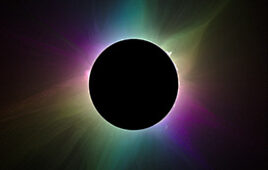In this simulation of X-ray emission near a black hole, colors correspond to radiation intensity and the black bars indicate the X-ray polarization direction. The disk is viewed almost edge-on. The outer parts of the disk emit X-rays polarized parallel to the plane of the disk. Close to the black hole, the curvature of spacetime warps the photon trajectories, and photons returning to the disk lead to a net-polarization perpendicular to the plane of the disk. NASA/Goddard Space Flight Center/Schnittman et al. |
Henric
Krawczynski, PhD, professor of physics in Arts & Sciences at
Washington University in St. Louis, is a big-game hunter of the
astrophysical variety—he hunts celestial beasts, not beasts of the
forest. The more exotic and wilier the prey, the keener he becomes, and
the more his eyes light up.
The
National Aeronautics and Space Administration (NASA) has just funded
Krawczynski and his colleague, assistant research professor Matthias
Beilicke, PhD, to chase some of the most exotic astronomical prey: black
holes, those famously elusive quarry that cleverly swallow most of the
evidence of their existence.
He
will be doing it with an instrument Jules Verne would appreciate, a
balloon-borne telescope sensitive to the polarization of light that will
float at an altitude of 130,000 feet for a day. During that time, the
balloon will stare fixedly at two black holes in our galaxy, an
extragalactic black hole, an accreting neutron star, the Crab nebula,
and other targets yet to be chosen.
Called
X-Calibur, the instrument, which is sensitive to “hard” X-rays with
energies between 20,000 and 60,000 electron volts (eV), is scheduled to
go up in the spring 2013 or fall 2014. It will be flown at roughly the
same time as another mission, GEMS, a satellite-borne instrument
sensitive to “soft” X-rays, with energies between 2,000 and 10,000 eV.
For comparison, visible light has energies between 2 and 3 eV.
Krawczynski
leads the X-Calibur experiment, whose development was sponsored by the
McDonnell Center for the Space Sciences at Washington University.
Krawczynski is a science collaborator on the GEMS experiment, which is
led by Jean Swank, PhD, of the Goddard Space Flight Center.
To
date, astronomers have measured X-ray polarization from only one
astronomical source outside the solar system, the Crab Nebula, a
supernova remnant in the constellation Taurus. GEMS is two orders of
magnitude more sensitive than the instrument that looked at the Crab.
X-Calibur extends the energy coverage into the hard X-ray regime,
Krawczynski says.
Like polarized sunglasses only better
“Whenever you look at the sky at a different wavelength,” Krawczynski says, “you see something completely different.”
So,
astrophysicists, ever hungry for new insights, have launched a fleet of
telescopes that cover most of the electromagnetic spectrum, from the
lazy infrared to the jazzed-up gamma rays.
“We
are in a golden age of astrophysics,” Krawczynski says, “because we
have great observatories. But it has also become more difficult to make
the case for a new scientific tool. We need a technological breakthrough
or new observables,” he says.
The scintillator rod glows blue in the laboratory prototype of X-Calibur. The image shows the partially assembled instrument with three out of eight detector rings. |
X-Calibur
offers a little of both, but its main claim to fame are two new
observables: the polarization degree and direction of X-rays, which
provide information about cosmic sources that is not available in any
other way.
Electromagnetic
waves (light, included) are composed of electric and magnetic waves
that vibrate at right angles to one another and to the direction of
travel of the light wave. When light is unpolarized, the direction of
vibration of the electric or magnetic wave is random. When the light is
polarized, the waves vibrate in a particular direction.
Light can be polarized by various processes, including reflection and passing through certain materials.
Most
everyone has limited experience with polarization in the form of
glare-free sunglasses. Some animals, like shrimp and bees, live in a
vividly polarized world and use polarization-sensitive eyes to see what
other species cannot see.
“But
designing an instrument to detect polarization is difficult,”
Krawczynski says, “because we need a lot of photons to measure it
accurately. Whereas physicists can measure the energy or direction of a
single photon, they need as many as 10,000 photons to detect a 5%
polarization signal with high confidence.”
Inside X-Calibur
The scintillator rod at the heart of the X-Calibur experiment scatters X-rays into rings of detectors surrounding it.
The
rod deflects X-rays by a process called Compton scattering, which was
first observed by Arthur Holly Compton in 1923 at Washington University.
The building that houses Krawczynski’s lab was named after Compton.
In
this type of scattering, the X-ray photons colliding with electrons in
the rod are scattered at an angle to their original direction of flight.
The
rod is made of a “light” material that Compton scatters photons with a
high likelihood towards “heavy” solid-state detectors, which efficiently
absorb the photons.
If
the incoming photons are polarized, the outgoing photons will be
scattered preferentially perpendicular to the orientation of the
vibrating electric field.
“If
you can measure the directions in which the photons are scattered, you
can infer the polarization direction of the X-rays,” Krawczynski says.
The
assembled instrument will be flown in spring 2013 or fall 2014 in a
1,600-kg (3,500-pound) gondola developed by the Goddard Space Flight
Center that will hang from a balloon at an altitude of 40 km (25 miles).
“The
gondola will swing a bit, but we need to focus the telescope on a
celestial object with an accuracy of a sixtieth of degree,” Krawczynski
says.
The
telescope, which is slowly spinning to minimize systematic measurement
errors, is suspended in the gondola by a single high-pressure ball
joint. The telescope acts like the rotor in a gimbaled gyroscope. No
matter how its surroundings move, its optical axis remains firmly
pointed in the same direction.
Aboard
the gondola is an X-ray mirror developed by Hideyo Kunieda and his team
at Nagoya University. The mirror looks more like a giant apple slicer
than the usual bathroom mirror.
Two images of the Coma cluster demonstrate how different celestial objects can look at different wavelengths. The optical image (left) reveals roughly 3,000 galaxies, each of which contains billions of stars. The X-ray images (right) show a blob of hot gas ejected from stars in the galaxies over a period of about a billion years, some of it at a blistering temperature of 100,000,000 degrees Celsius. The gas has five to 10 times the mass of the galaxies. Optical Image: Kitt Peak National Observatory. X-ray image: ROSAT/MPE/S. L. Snowden |
If
X-rays strike a mirror at angles close to the perpendicular, they are
likely to be absorbed, not reflected. To be reflected, they must hit the
mirrors at grazing angles, typically less than 2 degrees. To
accommodate these physics, an X-ray mirror consists not of a single
reflective layer but instead of a 256 nested cylindrical mirrors. These
concentric mirrors act as a lens, focusing the X-rays onto the tiny
scintillator pin at a distance of 8 m.
Because
of the mirror and features of the instrument are designed to maximize
Compton events and discard imposter events, X-Calibur detects many more
of the incoming X-rays and is roughly one order of magnitude more
sensitive than competing experiments in the high-energy range.
What the telescope might spy
Already
on the target list for X-Calibur are one pulsar (the Crab Nebula), two
galactic black holes (Cyngus X-1 and GRS 1915+105), an accreting neutron
star (Hercules X-1), and one supermassive extragalactic black hole
(Markarian 421).
“The
most exciting targets for the telescope are the black holes and their
plasma outflows,” Krawczynski says. “One of the things GEMS and
X-Calibur will be able to measure is how fast the black holes are
spinning.”
In
the binary system Cygnus X-1, for example, a 15-solar-mass black hole
gobbles up matter from a companion star. Like water going down the
drain, the material spirals toward the black hole, forming a flat disk
that gets hotter and hotter as the material gets closer and closer to
the event horizon of the black hole.
Near
the outer edge of the accretion disk, Krawczynski says, the emitted
X-rays are polarized parallel to the plane of the disk. Closer to the
black hole, the black hole curves spacetime to such an extent that many
X-rays originally traveling away from the disk return to the disk and
are then scattered towards the observer.
“The
net effect,” Krawczynski says, “is that we will see a 90-degree
polarization swing produced by the gravity of the black hole.”
But that’s not all. The polarization swing will occur at an energy that depends on how fast the black hole is spinning.
“Black
holes and their accretion disks shrink as they rotate,” Krawczynski
says. “The faster the black hole spins, the closer is the accretion disk
to the black hole, and the lower is the energy at which the
polarization swing will be observed.
“The energy at which the polarization swings is thus a direct indicator of the spin of the black hole,” he says.
Black
holes and pulsars are not the only celestial targets in Krawczynski’s
sights. He mentions the possibility of testing the theory of general
relativity near a black hole.
General
relativity has been repeatedly validated in the wimpy gravitational
fields of the Earth’s solar system. But what happens, Krawczynski
wonders, close to a black hole where spacetime is tied into a knot, and
the potential well plunges to infinity?
His eyes light up at the very thought.







